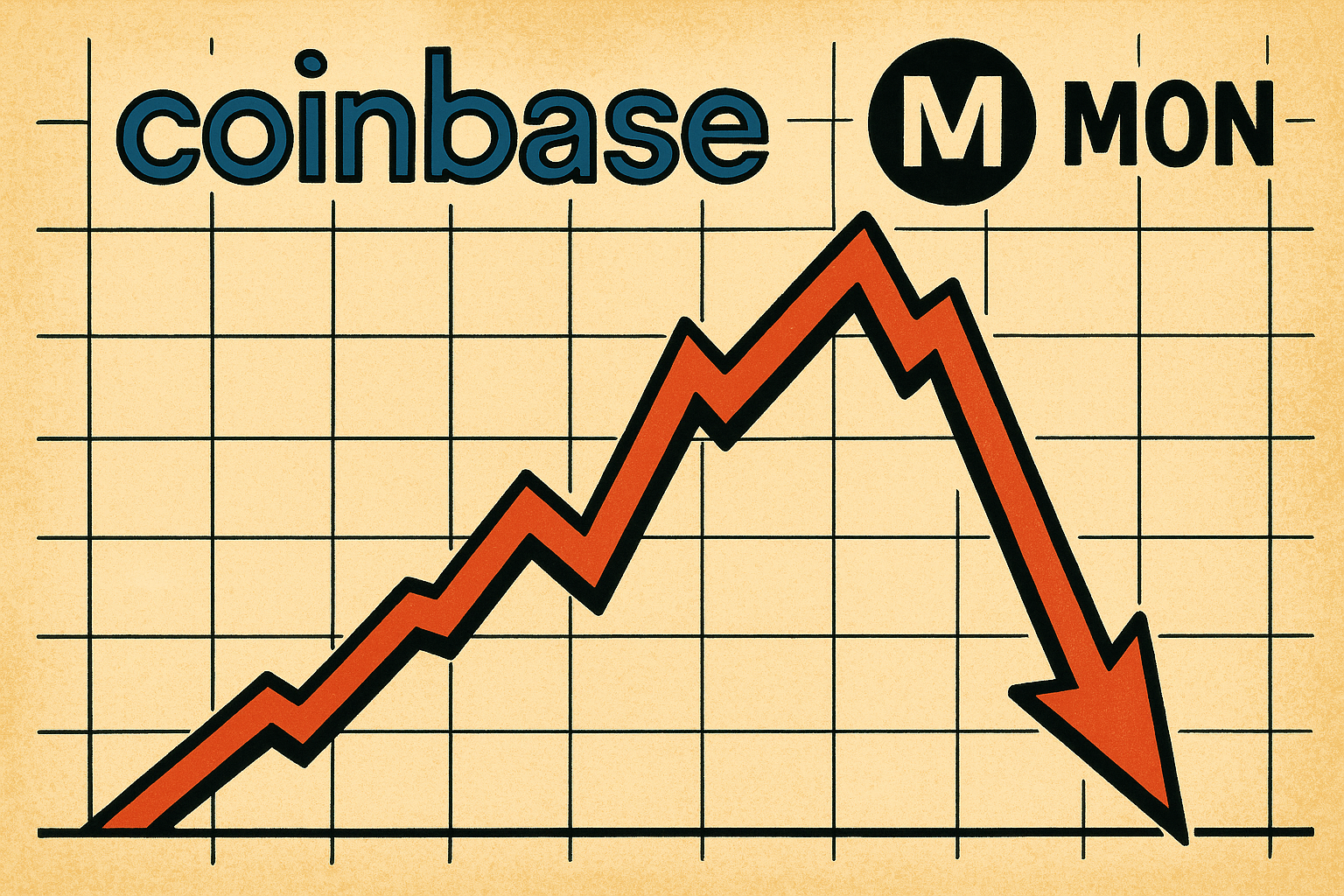News
Coinbase Ventures Unveils 9 Strategic Crypto Bets for 2026

- Share
- Tweet /data/web/virtuals/383272/virtual/www/domains/theunhashed.com/wp-content/plugins/mvp-social-buttons/mvp-social-buttons.php on line 63
https://theunhashed.com/wp-content/uploads/2025/11/Coinbase-1000x600.png&description=Coinbase Ventures Unveils 9 Strategic Crypto Bets for 2026', 'pinterestShare', 'width=750,height=350'); return false;" title="Pin This Post">
A Signal to the Market: Coinbase Is Looking Ahead
Coinbase Ventures has outlined nine high-conviction areas in crypto and blockchain it plans to back through 2026, offering a rare glimpse into how one of the space’s most influential investors sees the industry’s next evolution. Rather than focusing on short-term hype, the firm is zeroing in on structural innovations with long-term market potential—from tokenized real-world assets to AI-driven blockchain tools and the next wave of DeFi.
Real-World Assets and Synthetic Exposure
At the top of Coinbase’s list is the tokenization of real-world assets (RWAs), including physical assets and financial instruments. Of particular interest are perpetual futures that give synthetic exposure to off-chain markets. This category holds promise as a bridge between traditional finance and on-chain systems, allowing investors to access diversified risk and utility without leaving the crypto-native environment.
These new instruments may lower the barrier between DeFi and TradFi, helping shift blockchain’s narrative from speculative gambling to legitimate financial infrastructure. Investors are watching closely as new tokenized strategies begin to resemble the structured products of Wall Street—only this time, accessible to anyone with a wallet.
Specialized Exchanges and Smarter Trading Tools
Coinbase Ventures also plans to fund next-generation exchanges—especially those targeting niche user groups and advanced trading needs. This includes platforms offering ultra-fast execution, cross-chain support, multi-wallet management, and programmable order types.
One experimental area gaining attention is the development of proprietary automated market makers (prop-AMMs). These are designed to protect liquidity providers from predatory bots and sophisticated arbitrageurs, aiming to improve fairness and depth in decentralized trading markets.
DeFi 2.0: Beyond Lending and Yield
Coinbase believes the DeFi stack is ripe for a second transformation. The next wave will involve composable protocols that integrate novel loan structures, improved capital efficiency, and privacy-preserving features. Among the most anticipated use cases: uncollateralized on-chain lending based on user reputation, supported by off-chain data integrations.
Privacy-centric DeFi also features in Coinbase’s vision. Tools that allow for anonymous transactions or shielded balances—similar in spirit to Zcash—could gain momentum as users demand more discretion alongside decentralization. This reintroduces privacy as a fundamental right in DeFi’s evolving toolkit.
AI-Powered Infrastructure and On-Chain Robotics
Perhaps the most forward-looking part of Coinbase’s roadmap involves artificial intelligence. The venture arm is keen on tools that allow non-technical founders to deploy smart contracts and launch on-chain products with the help of AI agents. This could democratize protocol creation, reduce reliance on expensive audits, and cut time-to-launch significantly.
Coinbase is also tracking the rise of decentralized physical infrastructure networks (DePINs). These systems collect real-world data using physical nodes—drones, sensors, robots—coordinated via blockchain. The overlap with autonomous AI agents opens doors for robotics networks governed by on-chain economics.
Equally important is what Coinbase calls “proof-of-humanity”—identity protocols that combine biometrics, cryptographic signatures, and open standards to verify whether an actor is human or AI. In an era of synthetic agents and deepfakes, these systems could become essential for ensuring trust in digital interactions and decentralized governance.
Implications for Builders, Traders, and Investors
Coinbase’s investment thesis signals a shift in market focus. Instead of speculative tokens or viral apps, attention is moving toward foundational infrastructure—tools that can scale and support the next generation of decentralized applications. The key insight: value will increasingly flow into middleware and infrastructure layers, not just shiny frontends or memecoins.
For traders, the opportunity lies in identifying which primitives will win adoption: which tokenization protocols will become standards, which DeFi credit systems will reach critical mass, and which AI-based platforms can actually ship production-ready tools. For long-term investors, these nine areas outline where to look for the next cohort of breakout startups.
This is not just a roadmap—it’s a pivot point in how Web3 is being reimagined. The age of “number go up” might be giving way to “infrastructure gets built.”
What to Watch Next
If Coinbase Ventures is right, expect to see increased capital and talent flow into sectors like synthetic asset markets, DeFi privacy layers, DePIN networks, and AI-assisted development tools. Regulation will play a major role too. As frameworks like MiCA in Europe begin to formalize how tokenized assets are treated, the feasibility of these innovations will sharpen.
Ultimately, Coinbase’s 2026 blueprint shows how crypto might mature into a multilayered ecosystem where financial, technological, and even biological dimensions intersect. The vision isn’t just digital money or decentralized finance—it’s a new form of programmable infrastructure underpinning everything from capital markets to machine intelligence.
Ethereum
Small Kingdom, Big Move — Bhutan Stakes $970 K of ETH via Figment to Back National Blockchain Ambitions

Bhutan Turns Heads With Institutional‑Grade ETH Stake
The government of Bhutan quietly moved 320 ETH — worth roughly $970,000 — to Figment, the well-known staking provider, signaling a major shift in how the Himalayan kingdom engages with crypto. Rather than a speculative or retail‑style buy, this is an institutional‑level stake: the amount deployed corresponds to 10 full Ethereum validators (since each validator requires 32 ETH).
More Than Just Yield: Bhutan Anchors Crypto in Governance
Bhutan’s ETH stake comes on the heels of a far broader crypto‑adoption push. In October 2025 the country launched a sovereign national digital identity system — built not on a private chain, but on the public Ethereum blockchain. The decision to anchor citizen identities on a decentralized, globally supported network like Ethereum underscores a long‑term vision: decentralized identity, on‑chain transparency, and national infrastructure built with blockchain.
For Bhutan, this ETH stake isn’t about short‑term price swings or hype — it reflects a strategic bet on Proof‑of‑Stake infrastructure. By running validators via Figment, the government contributes to network security, potentially earns rewards, and aligns its own holdings and governance systems with the protocols underlying its digital‑ID rollout.
What This Signals for Ethereum — and for Crypto Governance
Though 320 ETH is a drop in the bucket compared to total staked ETH globally, the move carries symbolic weight. A sovereign state publicly committing funds to ETH staking via a recognized institutional provider adds to the broader narrative: that Proof‑of‑Stake networks are maturing, and that blockchain can underpin more than speculative assets — it can support identity, governance, and long-term infrastructure.
Moreover, it highlights that institutional staking services like Figment are increasingly trusted not only by hedge funds or corporations, but by governments. According to Figment’s own data, their Q3 2025 validator participation rate stood at 99.9%, and they reported zero slashing events — underlining the reliability such clients are counting on.
What to Watch Next
Will Bhutan stake more ETH? On‑chain data shows the wallet still holds a portion of ETH that remains unstaked — suggesting potential for future validator additions.
Will other nations follow suit? If Bhutan’s mixed use of crypto — combining reserve assets, public‑service infrastructure, and staking — proves viable, it could serve as a blueprint for other smaller states looking to modernize governance with blockchain.
Will this affect ETH’s valuation? Hard to say immediately. The 320 ETH is unlikely to move market prices by itself. But if this step becomes part of a larger trend toward institutional and sovereign staking, the cumulative effect on demand and network security could indirectly support ETH’s long-term value proposition.
Altcoins
Meme Coins Are Losing Their Mojo — From 20 % of Crypto Buzz to Just 2.5 % This Year

Meme‑Coin Hype Takes a Hard Hit
A recent report shows that collective interest in meme coins has plunged from about 20 % of all crypto chatter in late 2024 to roughly 2.5 % by October 2025 — a collapse of nearly 90 %. This shift reflects not only a drop in social buzz but also a broader retreat of speculative enthusiasm across the market. What once felt like the wild west of crypto — rapid launches, viral marketing and huge price swings — is cooling fast.
Market Metrics Confirm the Slide
The decline isn’t just anecdotal. Over the past year, more than 13 million meme tokens flooded the market, many with little to no utility — and most quickly vanished or failed. In a sector built on hype, many of these coins turned out to be short‑lived bets. Overall, the fully diluted market capitalization of memes has dropped by nearly 50 % year‑to‑date, according to blockchain analytics firms.
Trading volume has also cratered. In the first quarter of 2025, memecoin trading volume reportedly fell by 63 %. In many markets, memecoins’ share of overall trading volume dropped below 4 %, marking a dramatic retreat from their previous prominence.
What’s Driving the Decline
The collapse appears driven by a mix of oversaturation, weak fundamentals, and shifting investor preference. The meme‑coin ecosystem became overcrowded — tens of millions of projects launched, many with no clear roadmap or utility beyond chasing quick returns. That oversupply, combined with a broader crypto market slump, has wreaked havoc on liquidity and investor confidence.
Some analysts also cite growing regulatory scrutiny and a rising demand for real utility and transparency rather than hype‑driven “get‑rich‑quick” schemes. Meanwhile, capital and attention are rotating toward more tangible crypto sectors — such as AI‑powered tokens, infrastructure projects, DeFi, privacy coins and even traditional‑finance–style crypto instruments.
Could This Be a “Generational Bottom”?
Some within the community argue that the crash may bottom out soon — and that a new cycle could follow. Once the “dead weight” of unsustainable projects is cleared out, more serious, utility‑driven tokens could regain attention. Others believe the meme‑coin era may be effectively over — that the speculative mania has dissipated, and unless a meme coin brings real innovation or value, investors will avoid it.
Broader Implications for Crypto Markets
The downfall of meme coins underscores a broader maturation of the crypto industry in 2025. Markets appear to be shedding excess speculation and gravitating toward assets with fundamentals. This could lead to healthier ecosystem growth, better token design, and more sustainable long‑term investment — but also less room for high‑risk, high‑reward “moonshot” plays that defined crypto’s early years.
Altcoins
NYSE Arca Files to Launch Altcoin-Focused ETF

Fresh Rule‑Change Proposal Seeks Green Light From SEC
A fresh proposal filed by NYSE Arca could soon bring a new kind of cryptocurrency investment product to the U.S. market. In partnership with asset management giant T. Rowe Price, the exchange is seeking regulatory approval to list an actively managed crypto ETF that goes beyond Bitcoin and Ethereum. If approved, the fund would give investors exposure to a mix of top altcoins—like Solana, XRP, Cardano, and more—through a traditional stock exchange, eliminating the need for wallets, private keys, or crypto trading accounts.
What the Fund Would Do: A Broad, Actively‑Managed Crypto Basket
The Fund isn’t a passive single‑asset product but aims for active management. Its objective is to outperform the FTSE Crypto US Listed Index over the long term.
At launch the Fund intends to hold a diversified basket of “Eligible Assets,” which currently include major tokens such as Bitcoin (BTC), Ether (ETH), Solana (SOL), XRP, Cardano (ADA), Avalanche (AVAX), Litecoin (LTC), Polkadot (DOT), Dogecoin (DOGE), Hedera (HBAR), Bitcoin Cash (BCH), Chainlink (LINK), Stellar (XLM), and Shiba Inu (SHIB).
The Fund may hold as few as five, or as many as fifteen, crypto assets at any given time — and is not strictly tied to the index’s weighting. It may over‑ or underweight certain assets, or include crypto outside the index, guided by active selection criteria such as valuations, momentum and fundamental factors.
The idea is to give investors exposure to a diversified crypto portfolio without having to manage wallets, custody, and rebalancing — while potentially delivering better returns than a static, index‑tracking fund.
Risk Controls, Custody and Governance
To ensure safety and regulatory compliance, the Fund will store its crypto holdings with a dedicated crypto custodian. Private keys will be secured under strict controls, preventing unauthorized access or misuse.
When the Fund stakes any crypto (if staking is employed), it will maintain policies to ensure sufficient liquidity to meet redemptions, especially if a large portion of assets becomes illiquid or locked.
Valuation of the crypto holdings — used to compute Net Asset Value (NAV) per share — will rely on reference rates from third‑party price providers, aggregated across multiple platforms. The NAV will be computed daily, aligned with close of trading on the Exchange or 4:00 p.m. E.T.
Why It Matters for Crypto and Traditional Finance
This filing reflects a broader shift in traditional financial markets embracing diversified, regulated crypto investment vehicles. Unlike earlier spot‑crypto ETFs designed for single assets (e.g., Bitcoin), this Fund proposes a multi‑asset, actively managed basket — potentially appealing to institutional investors and diversified‑portfolio allocators seeking crypto exposure with traditional ETF convenience.
If approved, the Fund would offer a streamlined, compliance‑friendly bridge between traditional capital markets and crypto assets, lowering operational friction for investors who prefer not to deal with wallets, exchanges, or self‑custody.
The approach may also set a precedent: showing that active crypto ETFs can meet listing standards under rules originally written for commodity‑based trusts. This could open the door for more innovation — perhaps funds targeting niche themes (smart‑contract tokens, layer‑2s, tokenized real‑assets) while still abiding by exchange and regulatory requirements.
What’s Next
The SEC review period typically spans up to 45 days from publication (or longer if extended), during which comments from market participants and the public may shape the final decision.
If approved, it may take some additional time before shares begin trading — during which documents like the fund’s prospectus, ETF symbol, and listing date will be finalized and disclosed by the sponsor.
-

 Cardano2 months ago
Cardano2 months agoCardano Breaks Ground in India: Trivolve Tech Launches Blockchain Forensic System on Mainnet
-

 Cardano2 months ago
Cardano2 months agoCardano Reboots: What the Foundation’s New Roadmap Means for the Blockchain Race
-

 Cardano2 days ago
Cardano2 days agoSolana co‑founder publicly backs Cardano — signaling rare cross‑chain respect after 2025 chain‑split recovery
-

 Bitcoin2 months ago
Bitcoin2 months agoQuantum Timebomb: Is Bitcoin’s Foundation About to Crack?
-

 Cardano2 months ago
Cardano2 months agoAfter the Smoke Clears: Cardano, Vouchers, and the Vindication of Charles Hoskinson
-

 Cardano2 months ago
Cardano2 months agoMidnight and Google Cloud Join Forces to Power Privacy‑First Blockchain Infrastructure
-

 Ripple2 months ago
Ripple2 months agoRipple CTO David “JoelKatz” Schwartz to Step Down by Year’s End, but Will Remain on Board
-

 News2 months ago
News2 months agoRipple’s DeFi Awakening: How mXRP Is Redefining the Role of XRP











